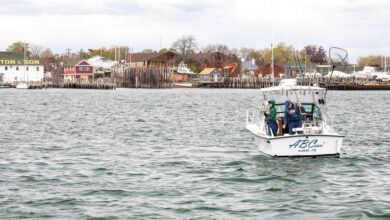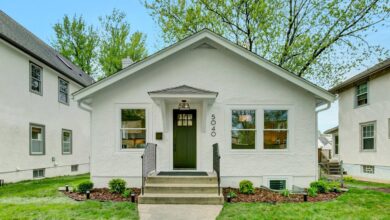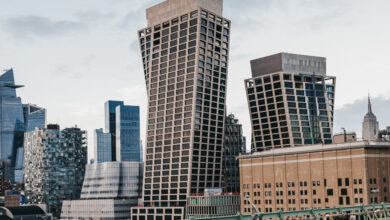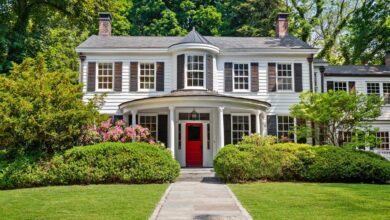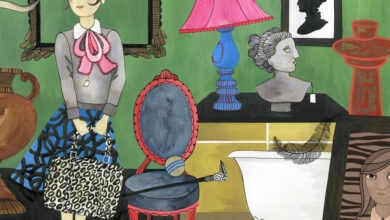Two Architects Create a Retreat in a Nerve-Racking City of Sarajevo

[ad_1]
More than 30 years have passed since Sarajevo, the capital of Bosnia and Herzegovina and once a model for multicultural harmony, became a shooting gallery.
In the 47-month-long siege of Sarajevo during the 1990s Bosnian war, more than 11,000 residents were killed and 50,000 wounded, mainly by mortar shells and snipers from Serb nationalist forces. Sixty-five percent of the city’s buildings were damaged, and 80 percent of its utilities infrastructure was destroyed.
Vernes Causevic, 37, was a young child during the siege. After his father was badly injured, his family escaped to London, where Mr. Causevic grew up to be an architect who never stopped looking back.
Today, he and his English-born partner, Lucy Dinnen, with whom he founded the studio Project V Architecture in London, explore architecture as a tool for postwar return, reconstruction and reconciliation.
“There has never been a serious statewide strategy for sustainable return in Bosnia and Herzegovina,” Mr. Causevic said, referring to the country’s more than 2 million citizens displaced during the war.
In 2017, the couple established a second home and office in Sarajevo, and in 2021 they paid about $80,000 for a 538-square-foot apartment in Grbavica (pronounced grr-BAH-vee-tsah). That neighborhood in the heart of the city had been notoriously occupied by Serb nationalist forces in wartime and used as a base for attacks, but was now attracting new residents.
The small unit in a Socialist-era building became not just their home but also a model for creating flexible, healthful environments. Rather than erasing the memory of traumatic events, the design pays tribute to the resiliency of Sarajevo’s citizens while proposing ideas for confronting a challenging future beset by climate change.
For the project — which they called Zemlja, the Bosnian word for “earth,” “land” and “country” — the architects removed three interior walls and installed terra-cotta-colored wool curtains that run along ceiling tracks. Snaking around the unit, the curtains respond to the occupants’ fluctuating needs for social interaction and privacy. Enclosing or expanding areas used for lounging, working, sleeping or eating, the fabric regulates light and alters moods with a tug of the hand.
The curtains also have historical resonance. During the war, Grbavica was sealed off from the rest of Sarajevo, and snipers positioned themselves within its towers. Getting rid of the apartment’s walls was symbolic of tearing down those barriers, Mr. Causevic said, but the curtains also refer to the bedsheets and tarpaulins strung between buildings beyond the neighborhood to block the shooters’ views.
“In our work and research, we are inspired by remarkable examples of creative citizen-made interventions that enabled people to adapt the architecture of their homes and streets to survive under siege,” Ms. Dinnen, 38, said.
The apartment’s “rooms” are anchored by custom-made furnishings, including an L-shaped desk unit with storage in the study area that serves as a bedroom cabinet on its reverse side and connects to a floor-to-ceiling bookshelf in the living area.
These fixed, functional islands are what give Zemlja its feeling of spaciousness, Mr. Causevic said. Often the strategy in small apartments is to do the opposite — untether the furniture, so it rolls around or changes states — but it is “uncomfortable and awkward” to transform a bed into a sofa or “live under your work space,” he said.
The retrofit, which cost the architects $25,000, responds to the question, “How do you create a really calming living environment for a stressful urban area?” Ms. Dinnen said.
Present-day Sarajevo not only bears wartime scars, but is coping with corruption, pollution and a fractured administration. The boundary line that divided Bosnia and Herzegovina into two entities after the war — one with a Bosnian Serb majority and the other with a Bosnian Muslim (Bosniak) and Bosnian Croat majority — is less than a mile from their flat.
The architects looked for resources that could improve human and economic health — including locally grown wood, which is abundant (more than half of the country is forested). Spruce replaces the plastic commonly found in windows, reducing condensation and the risk of mold. The herringbone floors are oiled white oak. The furniture is steamed beech.
The clay the couple found locally was used in a rammed-earth coffee table and living room shelves. They also bought clay plaster from a German company, Claytec, to coat their walls and ceiling, a humidity-regulating application that hadn’t been used in Sarajevo since decades before the war.
Other materials came from quarries, mines and factories in regions run by various authorities to bring together a palette that represents the cultural diversity of the country. Mr. Causevic called it “a metaphor for reconciliation.”
The builders joked that the curtains made the apartment feel like a theater, but they were impressed with the effect and loved working with the natural clay plaster, the architects recalled. “That was one of the key aims, to inspire this generation of builders, who were only used to doing things a certain way,” Mr. Causevic said.
Fundamentally, however, the project hews to Sarajevan architectural tradition by reflecting individual needs rather than citywide codes. This can be immediately appreciated in the unique treatment of balconies on the building’s exterior.
“One thing we celebrate in our design work and teaching is the ad-hoc-ism of Sarajevo,” Ms. Dinnen said. “This way of building and changing and repairing one’s own unit creates this incredible texture.”
Living Small is a biweekly column exploring what it takes to lead a simpler, more sustainable or more compact life.
For weekly email updates on residential real estate news, sign up here.
[ad_2]
Source link


